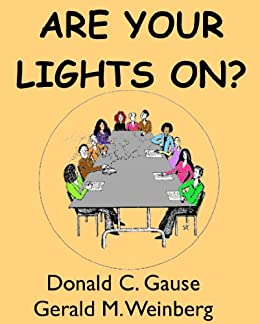Are Your Lights On
“Are Your Lights On” is a humorous exploration into the heart of Problem Solving. The book is fun, light-hearted, and profound, all at the same time.

Allegory
The book’s namesake allegory goes thus: There is a tunnel through a mountain, leading to beautiful Switzerland. As the engineer building the tunnel, you put a sign at the start that says WARNING: TUNNEL AHEAD PLEASE TURN YOUR HEADLIGHTS ON
After going through the tunnel, tourists regularly stop by the roadside to take in the beautiful views and have a picnic. However, they also forget to turn on their headlights, leading to an unwelcome surprise at the end of their lovely picnic: their car no longer starts because the battery has been drained.
As the engineer in charge of the tunnel, you must solve this problem. How should you do it?
The book explores a variety of questions that help one explore the heart of the problem: Whose problem is it? What is the actual problem? Should this problem be solved? What is a good solution?
In the case of our intrepid engineer, the problem is relatively straightforward, but the solution ranges from the over-complicated (put a sign that says turn your lights off, except if it’s night, in which case leave them on) to a gentle nudge. We learn that putting up a simple sign at the end of the tunnel does the trick. ARE YOUR LIGHTS ON?
Key Ideas
Problem solvers rush in with solutions before taking the time to define the problem being solved. Even experienced people fall into this trap, exacerbated by social pressure and a demand for haste. When in this mode, people find many solutions and compete for acceptance of a favored solution; they accuse each other of not being open to a particular solution or an alternate point of view.
The authors suggest a deeper exploration of the problem itself before jumping into coming up with solutions. In particular, they suggest asking some questions:
What is the problem?
A problem is defined as The difference between things as desired and things as perceived.
People often pass on a solution as the problem definition; it isn’t. Especially if it’s your solution method.
Defining the problem is very important: small word changes can substantially alter the problem definition. Play with it until it’s right.
Whose problem is it?
Close the gap between the person experiencing the problem and the person solving the problem.
Where does the problem come from?
Was it created by someone, e.g., an examination problem? These problems are often Puzzles, not Problems.
Do we really want to solve the problem?
Solutions beget other problems. Thus one problem is displaced with another problem. Our goal is to simply replace the current issue with one that is more tolerable (or one that doesn’t affect us.)
Not every problem should be solved. People may not know what they are asking for until you give it to them (and then they realize it isn’t.)
We never have enough time to consider whether we want it, but we have plenty of time to regret it.